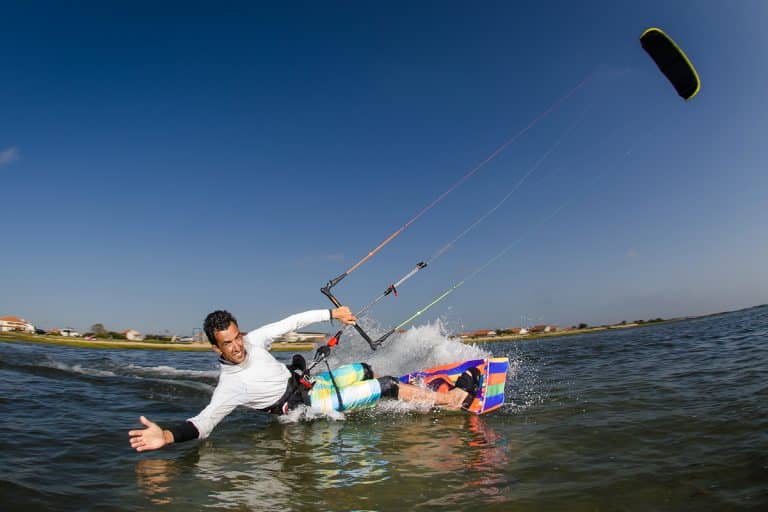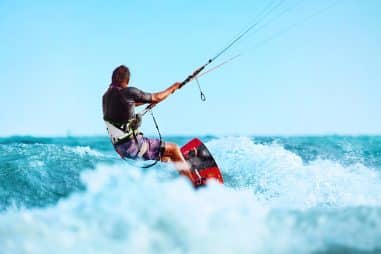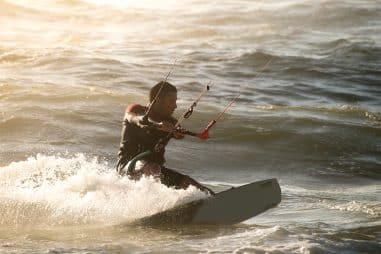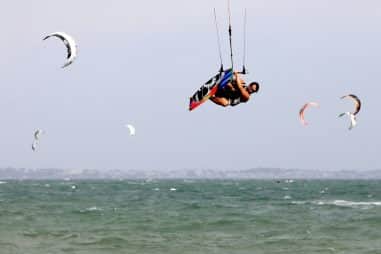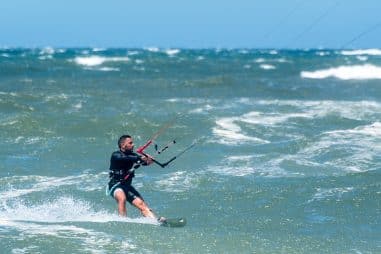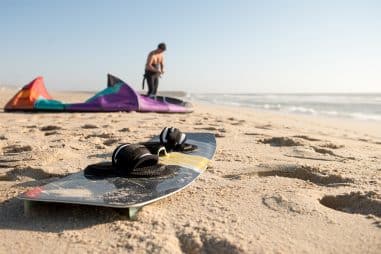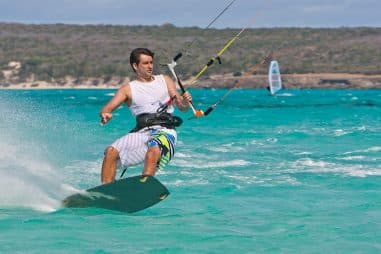The most costly and visible equipment for kitesurfing is the kite and the board. A kite can cost you about 1000 to 2000 dollars depending on the brand while the board approximately costs around 1000 dollars. Capitalizing on your kite and board combined with a decent control bar, kite lines, and harness will give you an edge in your learning progression.
How Expensive Is Kitesurfing?
Compared to other extreme sports, kitesurfing can get exceedingly expensive. If you can afford and would like to buy your own equipment, a starter package would usually cost approximately $1500. This includes a kite, a board, and a harness but you will need a lot more gear than this which means that you will be spending more than $1500 to purchase all the equipment you need to go kitesurfing.
You also have the less expensive option of renting gear if you just want to experience kitesurfing and save money. The price ranges from $250 to $300 per day and $500 to $700 per week. Having said that, you must bear in mind that kites are very delicate which makes them very easy to damage and the rental place might need you to pay for that if ever you ruin the kite or any other gear you rented.
Why Is Kitesurfing So Expensive?
There are several reasons why kitesurfing is extremely expensive. Listed down below are some of the many reasons:
- Popularity: Kitesurfing is not widely known among people which makes it a rather small community. There are only a handful of companies that make kitesurfing gear around the world and the production quantities are very, very little. On top of that, the consumers buy new gear at an alarmingly fast rate which is why kitesurfing gear is sold at an extremely high price.
- Gear: It is commonly known that you need a kite, a board, and a harness to go kitesurfing and this starter package costs roughly $1500. However, you need a lot more gear than these three things such as a control bar, spreader bar, air pump, kite lines, safety leash, air pressure gauge, a hose, and a lot more. This is what makes kitesurfing so expensive.
- Materials and labor: Special materials that are thin and light but still incredibly strong are used in making kites. The stronger and lighter your kite is, the higher the price it is sold. Additionally, kitesurfing gear is meticulously made by highly skilled professionals who are very passionate about the sport.
- Acquiring training: One of the great things about taking kitesurfing lessons is that you do not need to have any experience to enroll. The price typically starts from $50 per session but this greatly varies depending on the area. Most kitesurfing schools have a wide variety of kites that you can use in your training and most of the time, you don’t need to pay if you damage any gear because it is already included in the price which makes it a very good investment.
Now if you put all these factors together, it will certainly make sense why kitesurfing is very expensive.
What Equipment Do You Need for Kitesurfing?
Kitesurfing uses a lot of equipment and from time to time, you’ll leave something behind. Here’s a list of the essential equipment you need for kitesurfing so that you won’t forget to bring something on your next trip:
Basic Kitesurfing Equipment
- Kite
- Board
- Seat Harness
- Air Pump
- Control Bar
- Spreader Bar
- Kite Lines
- Safety Release System
- Straps
- Wetsuit
- Rash Guard
- Water Shoe
- Life Jacket
Optional Kitesurfing Equipment
- Helmet
- Impact Vest
- Gloves
- Boots
- Kite Bag
- Surf Camera
- Sunscreen
- Bag
- Anemometer
How Do You Get Kitesurfing Gear?
Before buying your first kitesurfing gear it is best to try out different kinds of brands of boards, kites, and bars. When kitesurfing at your local water park, you should consider trying first their kite rentals. It is best to change kites and boards from time to time if it’s permitted. This will help you have a feel of other sorts of kitesurfing gears and determine which is best suited for your style.
Kitesurfing gear can be bought online if you know what you are looking for it but for starters, it will be probably best to buy it at your kite shop so they can guide you in choosing kitesurfing gear that will best fit you. Getting your own kitesurfing gear will be a good investment if you kitesurf regularly.
What Is the Best Kitesurfing Brand?
Everyone has their personal preference for kitesurfing brand. If you are a beginner you may want to consider a brand that has more safety features and easier to control. Even though your kite’s speed and jump performance are just typical, having a more stable, responsive, and those additional safety features on your kite helps you stay grounded on your board.
For intermediate and expert kitesurfers there are lots of high-end brands to choose from like Airush, Blade, F-One, Flexifoil, Ozone, Cabrinha, Duotone, and Liquid force and the list goes on. Every detail matter for professional kite surfers, a slight difference in build can greatly affect the power, speed, and control of an expert rider. The best brand of kitesurfing gear depends on your personal feel, liking, and performance. Although the price differs greatly between kitesurfing brands, it is barely noticeable for non-professional surfers.
How Do I Choose a Kitesurfing Board?
To know your recommended board size, it is advisable to check a kiteboard chart. A kiteboard chart lets you know what size of the board is best fitted for you. Kiteboard chart depends on your height and weight, it is apparent that a larger person requires a bigger board size. Try different sizes and brands of boards before buying your own to know the size that you are comfortable with.
Every kiteboarder has a different kind of style when kitesurfing. To determine what size of board is suited for you, it is first important to determine what do you intend to do when riding on water. For kitesurfers who enjoy going high speed, exciting tricks, and big airs, you may want to take away a few cm on your recommended board length. If you plan on doing more cruising than jumping around the water, you can just stay on your suggested board length.
Can You Use a Normal Surfboard for Kitesurfing?
As kitesurfing gain more popularity, water sports enthusiast often wonders if they can use their existing equipment to try out other surfing sports. If you are one of the surfers who is curious if they can use their surfboard for kitesurfing, the answer is yes, you can totally use a normal surfboard for kitesurfing although there will be obvious changes in its performance.
Kiteboards are much stronger and heavier than a normal surfboard. Aside from weight kiteboards are build smaller than surfboards. Riding a surfboard for kitesurfing will most likely break your surfboard because forces are much higher in kitesurfing than regular surfing. Get a surfboard that will match your height and size for practice and have fun. It will be best to buy a cheap surfboard to know the type you are comfortable with before buying an expensive kiteboard.
Can You Kitesurf With a Wakeboard?
You can absolutely kitesurf using a wakeboard. These two boards have some similarities but the main difference is the rocker. A rocker is the amount of bent on the board. You can easily recognize this when comparing the two side by side.
Wakeboard tends to have more rocker than kiteboards because wakeboards are designed to ride at a more constant speed. Using a wakeboard for kitesurfing may also affect your speed, jump, and making transitions. Despite this difference, you can still enjoy kitesurfing using a wakeboard in your local water park.
What Size Board Should I Get for Kitesurfing?
There are key points to take note of when buying your board for kitesurfing. The size of the board will greatly depend on your size, weight, style, and the wind in your area. Your feel and comfort to the board will also determine in your personal choice of the right kind of board.
Here is a kiteboard chart depending on weight.
| Rider Weight | Kiteboard size | Kiteboard width |
| 120 – 150 lb / 54 – 68 kg | 132 – 148 cm | 42 cm |
| 150 – 200 lb / 68 – 90 kg | 145 – 160 cm | 44 cm |
| 200 and up lb / 90 and up kg | 150 – 165 cm | 46 cm |
Different kind of riding style also plays a part on determining the size of your board. If you are doing cruising, carving, and doing jumps occasionally it’s okay to stick with your current recommended board size. You are confident in your skills in doing big airs, fast riding and love doing air tricks you may prefer having a few centimeters shorter board than your average size.
Not all surfing locations have the same wind. If you are surfing where the wind is low and has some frequent lulls it will be better to have a larger board. Having a bigger board will help you stay afloat on these light winds. If your area has high wind speed, getting a smaller board will be more fitted.
How Do I Choose a Kite for Kitesurfing?
Choosing the right kite for kitesurfing may be confusing at first however familiarizing yourself with the kite chart will help you determine the perfect kite size for you. Same as choosing your board size, kite size is also determined by your weight, size, and wind speed.
Choosing the type of kite is based on your skill of style and skill in kitesurfing. Bow kites, Hybrid kites, and C-shape kites are the three types to choose from. Without getting into too much detail a bow kite is best for beginners, c-shape kites are used by expert kite surfers while hybrid kites or delta kites are like c kites but easier to de-power and relaunch from water.
What Size Kite Should I Buy for Kitesurfing?
The size of the kite you should buy depends largely on your weight and the wind speed on your location. Your kitesurfing level can also be a factor in determining your kite size. Choosing the right kite for you is a combination of your size and skill progression. Take a look at this kite chart to guide you in buying the perfect kite for you.
Kite Size Chart
| Rider Weight (kg) | 43 | 50 | 57 | 64 | 70 | 77 | 84 | 91 | 98 | 104 | 111 | 118 | Wind Speed | ||
| Rider Weight (lb) | 95 | 110 | 125 | 140 | 155 | 170 | 185 | 200 | 215 | 230 | 245 | 260 | knots | mph | kph |
| Kite Size (m2) | 3 | 3 | 4 | 4 | 5 | 5 | 5 | 6 | 6 | 7 | 7 | 8 | 34 | 39 | 63 |
| 3 | 4 | 4 | 5 | 5 | 6 | 7 | 7 | 8 | 8 | 9 | 9 | 28 | 32 | 52 | |
| 4 | 5 | 5 | 6 | 6 | 7 | 8 | 8 | 9 | 8 | 10 | 11 | 24 | 28 | 44 | |
| 4 | 5 | 6 | 7 | 7 | 8 | 9 | 9 | 10 | 11 | 12 | 12 | 21 | 24 | 39 | |
| 5 | 6 | 7 | 7 | 8 | 9 | 10 | 11 | 11 | 12 | 13 | 14 | 19 | 22 | 35 | |
| 6 | 6 | 7 | 8 | 9 | 10 | 11 | 12 | 13 | 14 | 14 | 15 | 17 | 20 | 31 | |
| 6 | 7 | 8 | 9 | 10 | 11 | 12 | 13 | 14 | 15 | 16 | 17 | 15 | 17 | 28 | |
| 7 | 8 | 9 | 10 | 11 | 12 | 13 | 14 | 15 | 16 | 17 | 18 | 14 | 16 | 26 | |
| 7 | 8 | 10 | 11 | 12 | 13 | 14 | 15 | 16 | 18 | 19 | 20 | 13 | 15 | 24 | |
| 8 | 9 | 10 | 12 | 13 | 14 | 15 | 16 | 18 | 19 | 20 | 21 | 12 | 14 | 22 | |
| 8 | 10 | 11 | 12 | 14 | 15 | 16 | 18 | 19 | 20 | 22 | 23 | 11 | 13 | 20 | |
| 9 | 10 | 12 | 13 | 15 | 16 | 17 | 19 | 20 | 22 | 23 | 24 | 10 | 12 | 19 | |
How Do You Know What Size Kitesurf to Get?
Your body weight and height are among the reasons what size kite is best for you. It is apparent that a bigger body needs a larger kite. However, having a too large kite might be dangerous, and using too little kite may not get you enough power. Getting the optimal size of kite is crucial to make your kitesurfing experience more enjoyable and safer.
Kiteboard should also be considered when choosing your kite size. If you are riding on a smaller board you might want to consider adding a few meters to your kite. Whereas reducing a little bit of your kite size is recommended if you are using a large board. These adjustments will balance your drag, speed, and jump while kitesurfing.
What Are the Best Kitesurfing Kites?
There’s a lot of brands of kitesurfing kites, although their performance and quality don’t drastically differ from one another, riding on your most comfortable and preferred brand gives you peace of mind and confidence on the water. You must have confidence in your gears while doing exciting tricks on the beach.
Individual skill level is another aspect of choosing a brand of kites. For more advanced and experienced riders Slingshot, Cabrinha, Liquid Force, Ozone, Duotone, F-one, Airush, and Core Kiteboarding are some of the most popular choices. If you are a beginner you may want to check Prism, Crazyfly, Flexifoil, and HQ kites. Riding different the kite will aid you in determining which brand fits your surfing style.
What Are Kitesurfing Kites Made of?
Polyester is the main material of almost all kitesurfing kites. It is the core material because of its durability, lightweight, flexibility and it is waterproof. Polyester is a synthetic polymer and has a wide variety. They are often used as an insulating material for their high UV resistance, this physical property of a polymer is an advantage for kites as it is always exposed to the sun.
Kites need to resist various potential damages. It is normal that it will regularly fall into water, grass, rocks, and sand. For this reason, other materials are also woven into the kite to make it sturdy, stable, and elastic. Even though kites are durable it is still susceptible to damage. Make to always clean your kite and keep it dry.
How Long Does a Kitesurfing Kite Last?
The average lifespan of a kite on normal use is around 6 to 7 years. Depending on how you take care of your kite can prolong or shorten its life. Always get rid of sands as it is the primary reason for deterioration on kites. Sands will rub again your kite fabric that causes it to tear.
Another kite destroyer is the heat. If you left it under the scorching sun it may melt the adhesive on the valves of the kite. Be sure to keep your gears in a secure location away from too much warmth. You can double the life of your kitesurfing equipment by religiously keeping it away from both sand and heat.
What Is the Best Kitesurfing Kite for Beginner?
Learning your first lessons on kiting as a student can be a serious challenge. A beginner’s kite should be stable, predictable, easy to relaunch, has a large wind range, good depower, and most importantly has an excellent safety system. Avoid using a c-shape type kite as it requires a higher skill level to use. Bow kite or delta kite may be the recommended type to learn from.
Renting different types and brands of kites can be a good experience to test your feel and to know your comfort level. It is also a good idea to buy a second-hand kite. Getting a bow kite will be the best option for a beginner since it is the slowest type, you will have more time to react and to plan your movements.
What Kitesurfing Kite Should I Buy?
In preparation for purchasing your own gear, have time to try out different kinds of kites. By renting equipment you’ll be able to get a feel of the type and brand that fits your styles. Your skill level plays a part in determining the kite you need. Inexperienced riders should steer clear of c-shape kites as it is harder to control.
For beginner kitesurfers, it is great to get a bow type to have that consistent slow speed. If you are a more experienced rider buying a delta or hybrid kites is a good investment to support you in your skill progression. Aside from kite type and riding ability, knowing the right size of kite is also vital in choosing your gear. Check out the kite size chart to know the ideal kite for you.
What Do You Wear to Kitesurf?
Like any water sport, it is best to wear a wetsuit. Additional gears are also worn to be fully prepared for kitesurfing. Putting on a harness and straps connects you to your kite with the help of the kite lines. A life jacket can also be considered if you are not that confident in deep waters and a helmet to protect your head.
Safety is a top priority in kitesurfing, don’t forget to properly equip your safety system. When kitesurfing in warm areas you should wear a rash guard, bathing suit, or board shorts. Avoid wearing loose clothing while surfing, as it causes drag and it can be very uncomfortable when you are doing jumps and riding very fast.
How Much Does a Kitesurfing Setup Cost?
The price of basic equipment for kiteboarding differs greatly specifically when comparing the high-end brands and the latest gear. To get started with your kiteboarding here is an estimate on how much it may cost.
- Kitesurfing Kite ($900 – $2100)
- Kitesurfing Board ($450 – $1100)
- Bar and Lines ($350 – $900)
Additional outfits and tools may be necessary depending on your location. If you are just trying out the sport, you may want to begin by renting equipment from your kiting school before buying your own gear. The range of kitesurfing lessons is around $70 to $90 per hour. An average person takes up to 6 – 12 hours to learn the basics of kiteboarding.

